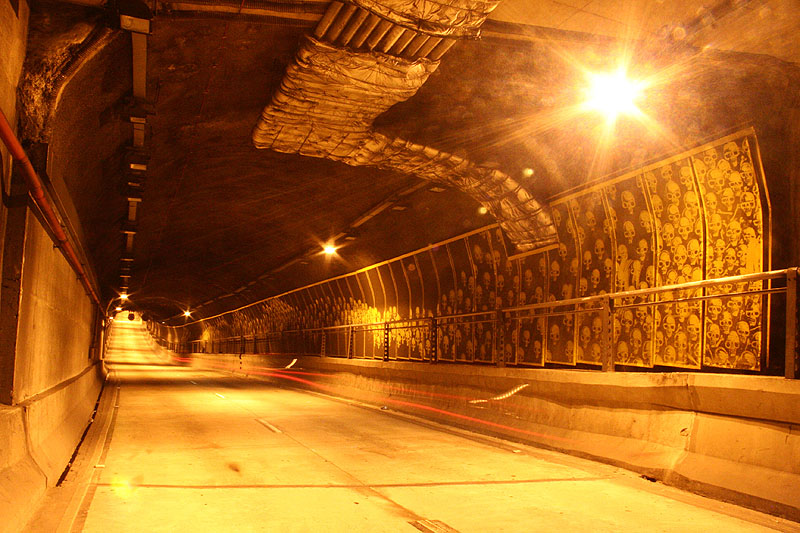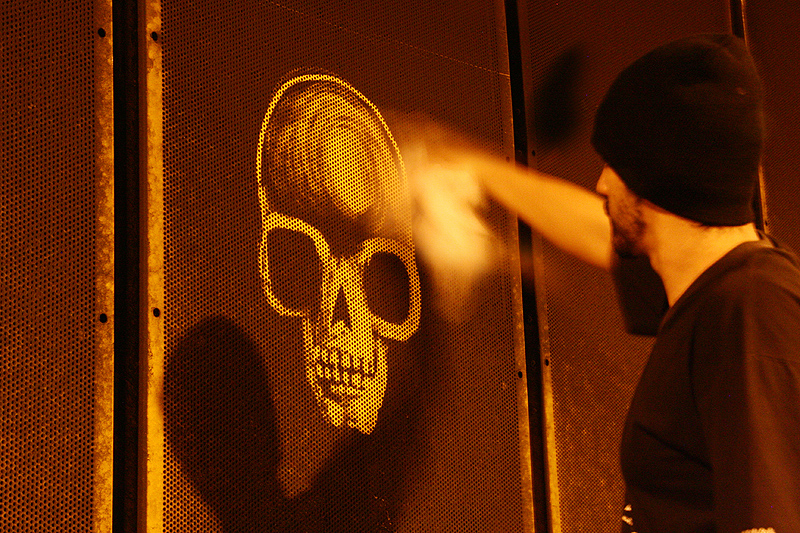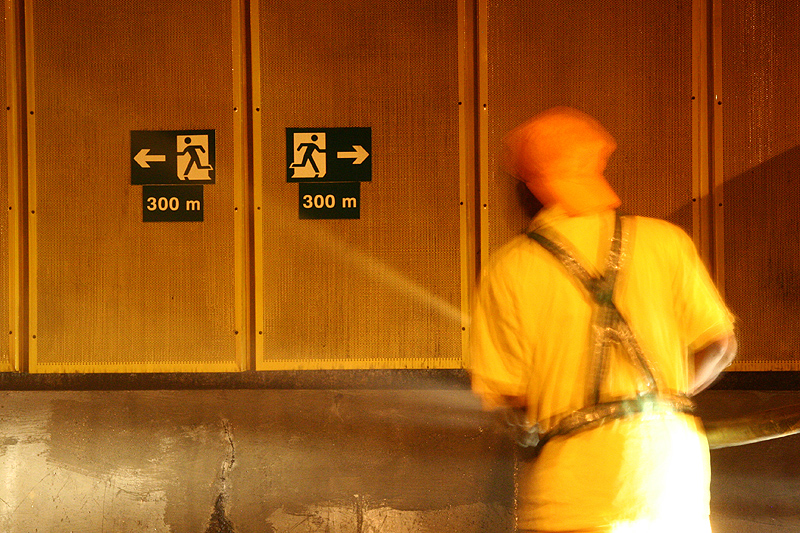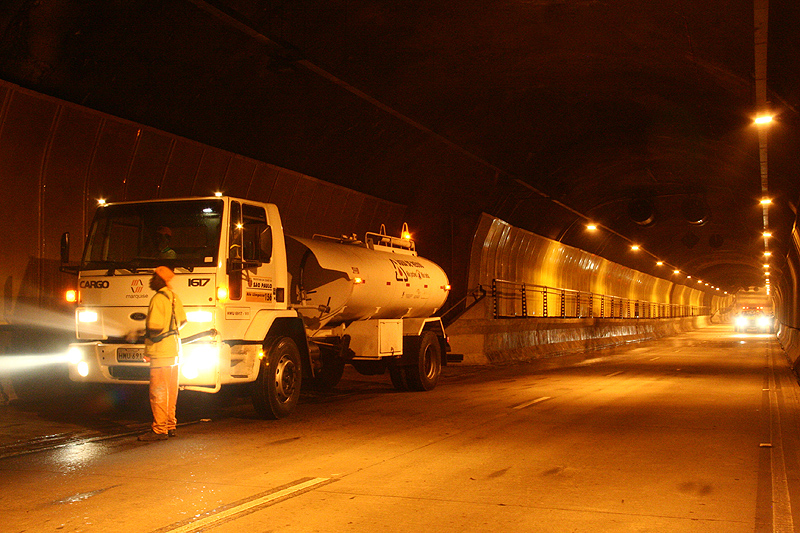It wasn’t long before the Max Feffer Tunnel in São Paulo became dirty. Opened in September 2004 and running east-west from the Praça Mário Bollo to Avenue Cidade Jardim, the tunnel serves as a short but critical artery in the network of roads through which the commuter traffic of a burgeoning megalopolis makes its daily commute. By 2006, the tunnel had been painted black by exhaust fumes, an underground monument to the impact of rapid growth. That summer, street artist Alexandre Orion enacted what he termed an “intervention.” Armed with little more than water, rags, and a respiratory mask, he began to selectively remove layers of soot from the wall, leaving images of human skulls in the newly cleaned negative space. The police came, but could do nothing—he hadn’t broken any laws. Eventually, the authorities returned with hoses and washed Orion’s work away—in the process, removing layers of soot. But since much of the tunnel remained dirty, Orion returned to work there in August. To prevent him from continuing, the authorities were forced to clean the entire tunnel—exactly what he had intended. Using a seemingly simple visual rhetoric, Orion crafted a macabre work designed to awaken São Paulo to its own dirty habits. Rather than a simple call to action, Orion enacted his own solution. He called it “The Ossuary”—Ossário.
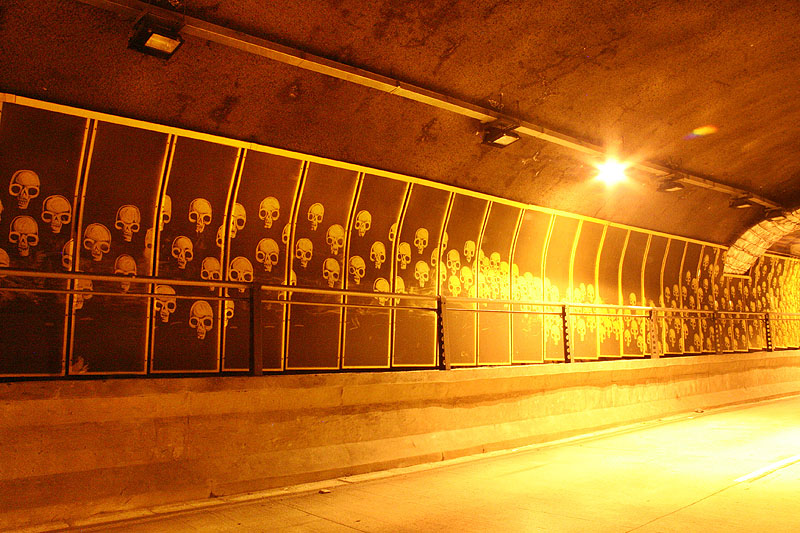
For a brief time, the Max Feffer Tunnel was turned into a visceral spectacle conjured from the depths of the most mundane of structures. From a skeleton of perforated metal and a concrete body Orion carefully excised an image by erasing the excretions of modern life in São Paulo. Ossário is a work whose formal qualities act as creation and accusation, each of its skulls staring guiltily at passing Paulistanos. José De Souza Martins has written, “from the ocular cavities of so many dead, [Orion’s] work looks out on the living and interrogates people passing by; it quietly criticizes our omission, our comfortable acceptance of pollution, our ‘I didn’t know about that.’” These eyes exist in a space between the recognizable pictography of the signifying “eye” and the shock of pollution, gazing at their public in judgment both as icons and the literal product of an environmentally destructive way of life. Designed for a capacity of up to six thousand cars per day, the tunnel is not a foreign space but a daily fixture in the lives of many Paulistanos habituated to the presence of filth in this space. The skulls present a confrontation where confrontation should not exist. Orion is literally cleaning up Paulistanos’ mess, “[scraping] the soot of our subdued urban consciousness from the walls,” and the symbol that remains stands as both a reminder and a challenge to São Paulo to change her dirty habits and clean those walls.
One can immediately recognize this provocation in the brute presence of the macabre symbols and unnatural lighting in an enclosed area bound to awaken one to its abnormality. The tunnel’s panel-lined walls are sequentially spaced; it is possible to envision these as frames of film that denote the passage of time from one to the next. The mobile gaze of the spectator works in conjunction with the panel structure of the tunnel walls and the movement of the car to create the illusion of being in a zoetrope.
However, the majority of Ossário’s viewers experience the work through photographs, video, and websites. Orion’s primary intention was for Ossário to shock civil authorities into action and a slumbering populace into awareness. Ossário’s physicality was always meant to be transitory, but it was created with a photographer and filmmaker close behind. Following its physical destruction, Ossário lives on as an effective provocation in photographs and on film, its reproductions testifying to its existence and its efficacy. Ossário thus manages to exist simultaneously as a work of art, and as a reproduction of its originary process that was intended to provoke its own destruction.
And the cleaning crews did come. “After [the second intervention],” writes Orion, “every tunnel in the city was cleaned. After finishing work on Cididade Jardim, Rebouças was next, followed by a number of other tunnels in the city.” Ossário’s visual novelty from the iconography of the skulls to the semi-legal method used in their creation, were only small parts of Orion’s argument. He set an example for turning art into provocation and participating in the change he wished to see.
Images courtesy of Alexandre Orion @ ossario.net
